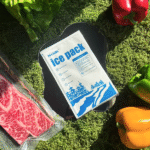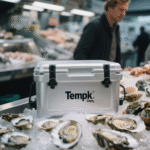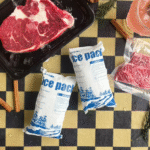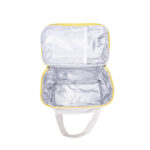Onde comprar pacotes de gelo seco em 2025 (e como escolher)
Se você precisar de bolsas de gelo seco hoje, você tem três caminhos confiáveis: redes de supermercados, fornecedores de gases especiais, e alternativas reutilizáveis de PCM - e a escolha certa depende da sua quantidade, duração, e necessidades de segurança. No primeiro 50 palavras que você está lendo agora, a palavra-chave principal Pacotes de gelo seco parece definir o contexto e a intenção. Espere regras práticas simples, uma tabela de dimensionamento, e uma calculadora que você pode usar em menos de um minuto. Este guia mescla e melhora seus três rascunhos.
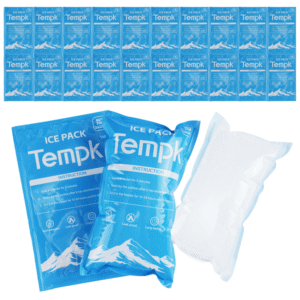
-
Onde comprar bolsas de gelo seco perto de você: supermercados versus. fornecedores de gás vs.. opções reutilizáveis on-line
-
Quantos pacotes de gelo seco você realmente precisa: regras rápidas para refrigeradores e pacotes
-
Como manusear bolsas de gelo seco com segurança: hábitos simples que evitam congelamento e ruptura das pálpebras
-
Se os pacotes PCM reutilizáveis de “gelo seco” cabem no seu caso: custo, segurança, e compensações de desempenho
-
2025 tendências: sustentabilidade, sensores, e produção sob demanda moldando a cadeia de frio
Quais varejistas oferecem bolsas de gelo seco perto de você?
Resposta curta: Para pequeno, necessidades no mesmo dia, verifique os supermercados locais; para pedidos maiores ou recorrentes, vá para fornecedores de gases especiais; para conveniência de envio, considere pacotes reutilizáveis de “gelo seco” PCM online. Você obterá disponibilidade previsível, melhor dimensionamento, e menos surpresas no balcão.
Por que isso é importante para você: As mercearias são convenientes, mas sazonais; alguns locais estocam apenas durante picos como verão ou Halloween. Fornecedores especializados mantêm estoque o ano todo, oferecer blocos ou pellets, e dar dicas de segurança na retirada. Pacotes de mudança de fase reutilizáveis são enviados legalmente e armazenados em casa – ótimo quando Pacotes de gelo seco não são práticos para transporte aéreo ou armazenamento em apartamentos.
Como confirmar a disponibilidade na loja para bolsas de gelo seco
Ligue primeiro, então planeje a coleta. Pergunte ao balcão de atendimento se eles estocam hoje, o tamanho típico do pacote (frequentemente blocos de 1–10 lb), e se limitam as quantidades. Para fornecedores especializados, solicitar pelotas (embalagem mais fácil) ou cortar blocos. Traga um refrigerador isolado, deixe a tampa ventilada, e use luvas. Se o estoque estiver apertado, migrar para pacotes PCM reutilizáveis para obter desempenho abaixo de zero equivalente.
| Tipo de fonte | Disponibilidade típica | Formatos comuns | O que isso significa para você |
|---|---|---|---|
| Supermercados | Sazonal / dependente da localização | 1– Blocos de 10 libras | Compras fáceis no mesmo dia; ligue antes |
| Clubes grandes | Volume sazonal | ~ blocos de 10 libras | Bom preço por libra; adesão necessária |
| Fornecedores de gases especiais | Durante todo o ano | Blocos, Pellets, lajes | Fornecimento confiável + orientação de segurança |
| Pacotes PCM reutilizáveis (on-line) | Durante todo o ano | -20Pacotes de °C a -26 °C | Enviar legalmente; manuseio mais seguro em casa |
Dicas práticas e ganhos rápidos
-
Incumbência curta: Compre 5–10 libras para uma viagem de um dia; ventile o refrigerador e separe os alimentos com papelão.
-
Parcela noturna: Escolha pellets e embale o produto; observe a rede Pacotes de gelo seco peso em sua etiqueta, se necessário.
-
Morar em apartamento: Armazene tijolos PCM reutilizáveis em seu freezer; sem gás, sem materiais perigosos, repetir o uso.
Caso real: Uma padaria precisava enviar tortas durante a noite para todo o estado. Eles usaram dez blocos de 2 libras de Pacotes de gelo seco em um refrigerador ventilado. Resultado: as tortas chegaram totalmente congeladas; custo de embalagem abaixo $5 por torta, e o manuseio permaneceu simples para a equipe.
Quantos pacotes de gelo seco você precisa para enviar ou viajar?
Regra geral: Planeje ~ 10 libras de Pacotes de gelo seco por 24 horas para um refrigerador de 24–30 qt; dobrar para 48 horas ou aberturas frequentes. Os blocos duram mais; pellets preenchem lacunas e esfriam uniformemente.
Detalhes que ajudam você a decidir: O que mais importa é o isolamento do contêiner, temperatura externa, massa do produto, e com que frequência você abre a tampa. Se sua rota ou tempo de espera forem incertos, adicione um buffer de 20–30%. Para contato com alimentos, mantenha uma camada (papelão/jornal) entre produto e Pacotes de gelo seco para evitar queimaduras de congelamento.
Embalagem Pacotes de gelo seco o jeito inteligente
Camadas e ventilação: Coloque uma fina camada isolante abaixo e acima do produto; coloque pellets nas laterais; mantenha a tampa ligeiramente ventilada para que o CO₂ possa escapar. Nunca use um recipiente hermético – a pressão pode aumentar. Use luvas isoladas; a -109,3°F (-78,5 ° C.), o contato com a pele nua pode causar ferimentos em segundos.
| Situação | Tamanho mais frio | Horas necessárias | Quantidade recomendada | Por que funciona |
|---|---|---|---|---|
| Dia do mercado dos agricultores | 24 Qt | 8–12h | 5Pelotas de –6 libras | Resfriamento uniforme; tampa abre frequentemente |
| Correio noturno | 30 Qt | 24 h | ~10 libras misturadas | Blocos + pellets prolongam o tempo de espera |
| 48-h viagem | 45 Qt | 48 h | 20– Blocos de 25 libras | Área de superfície inferior; perda mais lenta |
Os pacotes de PCM de “gelo seco” reutilizáveis são melhores para seu uso??
Resposta curta: Se você precisar de um manuseio mais seguro, envio padrão, e repita o uso, PCM reutilizável Pacotes de gelo seco muitas vezes são a melhor escolha; se você precisar de extremos de -78,5°C, ficar com CO₂ sólido. Os PCMs mantêm entre -20 °C e -26 °C de forma constante - ideal para alimentos, Diagnóstico, e envio diário.
O que isso significa: PCMs evitam regras sobre materiais perigosos, enviar por terra ou ar sem etiquetas especiais, e recarregue em um freezer. O CO₂ sólido atinge temperaturas muito mais frias, mas requer ventilação, luvas, e limites de idade em algumas regiões. Muitos remetentes misturam ambos: Pacotes de gelo seco para congelamento profundo, Tijolos PCM para manutenção constante.
Comparação rápida na qual você pode agir
| Recurso | Gelo seco (Co₂) | “Bolsas de gelo seco” PCM reutilizáveis | Sua lição |
|---|---|---|---|
| Temperatura | ~−78,5°C | −20°C a −26°C | Escolha com base nas necessidades do produto |
| Segurança | Pátria; ventilação necessária | Não perigoso; fácil manuseio | PCMs são fáceis de usar |
| Duração | Sublimação rápida | Espera estável | PCMs reduzem picos |
| Custo | Baixo por libra, uso único | Maior adiantamento, reutilizável | Usuários frequentes economizam com PCMs |
Dicas acionáveis
-
Remetente de fim de semana: Use blocos PCM para evitar os limites de materiais perigosos das companhias aéreas e reutilize-os semanalmente.
-
Amostras de laboratório a −20°C: Pré-condicione placas a -21°C em um freezer; registrar temperatura na chegada.
-
Eventos de sorvete: Combine uma base de Pacotes de gelo seco blocos com tampas PCM para suavizar oscilações de temperatura.
Manuseio seguro: os hábitos que evitam acidentes com bolsas de gelo seco
Práticas básicas: Use luvas/pinças, ventilar recipientes, e nunca sele o CO₂ em uma caixa hermética. Mantenha crianças e animais de estimação afastados. Permitir sobras Pacotes de gelo seco sublimar em uma área ventilada; não jogue no lixo ou afunde-os.
Por que é simples: O gás CO₂ desloca o oxigênio; a ventilação impede o aumento de pressão e mantém você seguro. Refrigeradores isolados - mas não herméticos - são seus amigos. Etiquetar pacotes com rede Pacotes de gelo seco peso, se exigido pela sua transportadora ou pista.
2025 desenvolvimentos e tendências para bolsas de gelo seco
O que há de novo 2025: Sustentabilidade e sensores lideram o caminho. Isolamento reciclável e sistemas PCM retornáveis reduzem o desperdício, enquanto os registradores Bluetooth de baixo custo mostram temperatura e localização ao vivo. Muitas PMEs adicionam peletizadores sob demanda para evitar gargalos na entrega e estabilizar a oferta quando a demanda aumenta.
Último em um olhar
-
Forros recicláveis & isolamento à base de papel: Reduza o aterro sem prejudicar o tempo de espera.
-
Sensores inteligentes em cada pacote: Alertas em tempo real reduzem desperdícios e reclamações de clientes.
-
Produção no local: Peletizadoras compactas encurtam os prazos de entrega e reduzem as emissões do frete.
Insight de mercado: Mercearia direta ao consumidor, sobremesas especiais, e diagnósticos continuam a crescer, empurrando sistemas mistos que emparelham Pacotes de gelo seco para segmentos ultracongelados com tijolos PCM para estabilidade final.
Perguntas frequentes
Q1: Onde é o lugar mais confiável para comprar bolsas de gelo seco?
Para pequenas quantidades, verifique supermercados próximos; para necessidades em massa ou repetidas, usar fornecedores de gases especiais. PCM reutilizável Pacotes de gelo seco on-line são melhores para remessas não perigosas.
Q2: Quanto gelo seco eu preciso para um refrigerador de 30 qt?
Sobre 10 libra para 24 horas. Dobre isso para 48 horas ou abertura pesada.
Q3: Posso enviar bolsas de gelo seco por via aérea?
Sim, mas siga as regras da operadora: embalagem ventilada e rotulagem de peso líquido para CO₂. Pacotes de PCM são enviados como materiais não perigosos.
Q4: Os pacotes reutilizáveis de “gelo seco” de PCM são tão frios quanto gelo seco real??
Não. Eles mantêm -20°C a -26°C de forma constante, que cobre a maioria dos alimentos e muitas necessidades médicas sem riscos de CO₂.
Q5: Que equipamento de segurança eu preciso?
Luvas ou pinças isoladas e proteção para os olhos ao quebrar blocos. Recipientes de ventilação para liberar gás.
Resumo & Recomendações
Três conclusões: 1) Escolha a fonte de acordo com a necessidade – supermercado, fornecedor, ou PCM on-line. 2) Dimensione o seu Pacotes de gelo seco com regras simples (~10 lb/24 h para 24–30 qt). 3) Manuseie com ventilação e luvas. Use a calculadora acima antes de comprar, e considere tijolos PCM reutilizáveis se você envia com frequência.
PRÓXIMOS PASSOS: Decida seu tempo de espera, escolher blocos vs. Pellets, e reserva de retirada. Para remessas repetidas, teste um kit PCM junto com Pacotes de gelo seco e adicione um sensor de baixo custo. Pronto para otimizar? Entre em contato com a Tempk para obter um plano de cadeia de frio personalizado e um kit de amostras.
Sobre Tempk
Projetamos e fornecemos sistemas de cadeia de frio – desde Pacotes de gelo seco e transportadores isolados para placas PCM reutilizáveis - para alimentos, farmacêutico, e Biotech. Nossas soluções visam temperaturas constantes, menor desperdício de embalagens, e custos previsíveis. Duas vantagens você obtém: dados de tempo de espera validados e suporte prático à configuração.
Chamado à ação: Obtenha uma consulta gratuita e plano de dimensionamento da Tempk hoje.

















